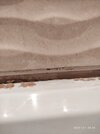I'm replacing the mouldy old sealant and there was an L-shaped plastic strip fitted previously, with the vertical part behind the tiles, so I had to use my multi-tool to separate that part from the horizontal part to remove the latter, as there was a load of mouldy old sealant under that and no way to remove it without removing the strip.
Now I've got a 20mm gap between the bath and the tiles, as shown in the attached photo. Would you just use sealant to fill that gap? I was thinking that there might be some sort of strip that I could stick on the tiles which would hang down and reduce the gap but maybe it's not worth it. If there is something like that, would I need to seal the top edge where it sits on the tile to stop water getting in between the strip and the tile?
Now I've got a 20mm gap between the bath and the tiles, as shown in the attached photo. Would you just use sealant to fill that gap? I was thinking that there might be some sort of strip that I could stick on the tiles which would hang down and reduce the gap but maybe it's not worth it. If there is something like that, would I need to seal the top edge where it sits on the tile to stop water getting in between the strip and the tile?



